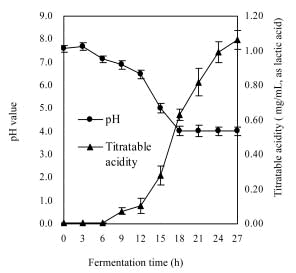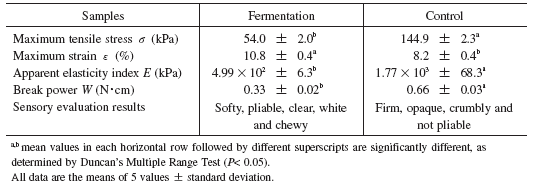Influence of natural fermentation on the physico-chemical characteristics of rice noodles
Description
[Objectives]
The natural fermentation of Indica rice is a traditional method used in producing high-quality rice noodles having specific functional properties in China. However, rice noodles produced in small, labor-intensive factories rely heavily on the worker's skill, and quality greatly varies with processing conditions. Little research has been done on the effects of fermentation on the physico-chemical characteristics of rice starch, and hence the effects of fermentation on rice noodles have not yet been elucidated. Thus, it is necessary to conduct studies in order to understand the relationship between fermentation and the rheological properties of rice noodles, as well as to standardize and increase the efficiency of its production. In addition, testing the fermentation technology for other rice cultivars and applying it to other starchy crops such as maize would contribute to increasing the value of raw grain materials. The overall objective of this study, therefore, was to investigate the influence of fermentation of whole-milled rice granules on the physico-chemical characteristics of rice starch and the rheological properties of rice noodles.
[Results]
Rice granule samples were fermented at 35°C for 27 h in an incubator until the pH value of the soaking water reached 4.0; samples soaked for 3 h were used as a control, and were very similar to non-fermented rice noodles. Fig. 1 shows that the pH of the fermented supernatant decreased to a minimum of 4.0 over 18 h. The maximum acidity reached was about 1.1 mg/mL (lactic acid) when fermented for 27 h. Fermentation did not have a significant effect on the starch and amylose content of rice granules; protein, lipid and ash content decreased, whereas free fatty acid levels increased during fermentation. The rice noodles made from fermented samples had lower maximum stress of 54 kPa, and higher maximum strain of 10.8%, and had a white, transparent appearance and favorable chewiness compared to control samples (Table 1). From these results, we concluded that fermentation decreases protein, lipid and ash content, freeing complex starch and increasing its expansion, thus facilitating the formation of hydrogen bonds. In general, it is considered that rice stored previously for more than 6 months makes better rice noodles than newly-harvested rice. This may be due to a similar protein and lipid content decrease, or an increase of free fatty acid content during the storage period.
Figure, table
-
Fig. 1. Changes in pH values and titratable acidity of the fermented supernatant (n=3). -
Table 1. Rheological properties and sensory evaluation of rice noodles.
- Affiliation
-
Japan International Research Center for Agricultural Sciences Food Science and Technology Division
- Classification
-
Technical A
- Term of research
-
FY2003 (FY2001-2003)
- Responsible researcher
-
TATSUMI Eizo ( Food Science and Technology Division )
SAITO Masayoshi ( Food Science and Technology Division )
Lu Zhan-Hui ( China Agricultral University )
LI Lite ( China Agricultral University )
MIN Weihong ( China Agricultral University )
- ほか
- Publication, etc.
-
Lu, Z., Li, L., Min, W., Li, Z. and Tatsumi, E. (2002): Influence of natural fermentation technology on the rheological properties of rice noodle. Journal of Chinese Institute of Food Science and Technology, 2, 8-12 (in Chinese).
Lu, Z., Li, L., Cao, W., Li, Z. and Tatsumi, E. (2003): Influence of natural fermentation on physicochemical characteristics of rice noodles. International Journal of Food Science and Technology, 38, 505-510.
- Japanese PDF
-
2003_21_A3_ja.pdf2.14 MB
- English PDF
-
2003_21_A4_en.pdf53.79 KB


